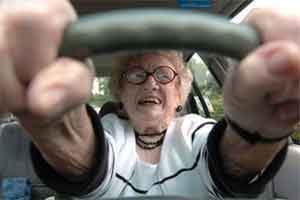Stroke survivors more likely to make dangerous driving errors
 Drivers who have had recent strokes are more likely than drivers who have not had strokes to make errors during complex driving tasks, according to two small Canadian studies presented at the American Stroke Association’s International Stroke Conference 2015.
Drivers who have had recent strokes are more likely than drivers who have not had strokes to make errors during complex driving tasks, according to two small Canadian studies presented at the American Stroke Association’s International Stroke Conference 2015.
“Current guidelines recommend that patients should refrain from driving for a minimum of one month after stroke. However, many patients resume driving within the one-month period after stroke, and few patients report receiving driving advice from a physician immediately post-stroke,” said Megan A. Hird, B.Sc., lead author of one of the abstracts and a master’s student at University of Toronto doing research at St. Michael’s Hospital, Toronto, Canada.
Hird and colleagues (abstract TP123) compared the driving performance of 10 mild ischemic stroke patients, within seven days of a stroke, to 10 people similar in age and education who had not had stroke. Using driving simulation technology, participants completed several driving tasks, from routine right and left turns to more demanding left turns with traffic, where most accidents occur, and a bus following task, requiring sustained attention.
They found:
Stroke survivors committed more than twice as many driving errors.
Stroke survivors had more errors during left turns with traffic and were almost four times more likely to make driving mistakes during the bus following task.
“Driving is a complex and multifaceted task,” Hird said. “Our study suggests that even patients with mild deficits may experience driving impairment, particularly during more cognitively demanding driving situations. More research is required to better characterize the driving performance of patients after stroke, so that healthcare professionals can better assess when it’s safe for stroke patients to resume driving.”
In another St. Michael’s Hospital, Toronto, Canada study, researchers reviewed the driving performance of patients who had suffered a type of bleeding stroke known as subarachnoid hemorrhages (abstract W MP54). Researchers used driving simulation technology to compare the driving performance of nine functionally independent subarachnoid hemorrhage patients, who had their strokes more than three months prior, to nine healthy volunteers. Subarachnoid hemorrhage is a stroke caused by bleeding at the base of the brain.
“We’ve long known that thinking, decision-making and functional limitations persist despite good recoveries among patients who suffer subarachnoid hemorrhage, but researchers and clinicians do not yet understand how these impairments impact real-world activities, such as driving a car,” said Kristin A. Vesely, B.Sc., study lead author and master’s student at the University of Toronto and St. Michael’s Hospital.
They found subarachnoid hemorrhage patients made a greater number of hazardous errors:
Subarachnoid hemorrhage patients had more than twice the number of collisions in simulated driving conditions and were three times more likely to drive outside road lines.
They made more errors during the most mentally-demanding driving maneuvers, including making left turns and left turns with oncoming traffic. But they did not perform worse than healthy drivers at making simpler right turns.
Errors by healthy participants were primarily due to driving above the speed limit.
“Today’s physician guidelines for assessing these patients’ driving ability do not provide objective, office-based assessment tools to help physicians identify unsafe drivers,” Vesely said. “Future studies should explore driving ability in a larger group of subarachnoid hemorrhage patients, to more clearly determine driving recommendations post-stroke. We need to understand which clinical characteristics can help predict certain driving impairments, leading to more targeted assessment and rehabilitation programs for individuals who may be able to safely resume driving.”
Source: American Heart Association
Full bibliographic information:
Stroke survivors more likely to make dangerous driving errors – Megan A. Hird, B.Sc.
Impairment in Cognitively Demanding Driving Situations after Acute Mild Ischemic Stroke – Kristin A. Vesely, B.Sc.
Increased Collisions and Errors at Intersections During Simulated Driving in Patients after Aneurysmal Subarachnoid Hemorrhage

